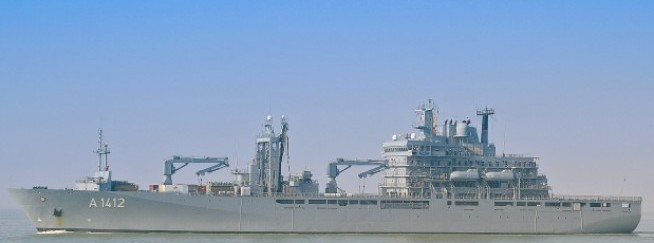Navy adopts German design for ships built in North Vancouver
Source: The Vancouver Sun
By: Zoe McKnight
Published: June 3, 2013
The federal government is a step closer to completing a $2.6-billion deal to build two naval supply ships in Vancouver.
Once the shipyard gets up and running, construction on two new naval vessels will bring over 1,000 jobs to North Vancouver.
The Department of Defence announced Sunday it has chosen to buy an existing design, based on the German navy’s new Berlin-class supply ships, from the Canadian division of German company TheyssenKrup Marine Systems, to replace two aging vessels.
The Royal Canadian Navy was slated to retire its two 45-year-old supply vessels, which have become environmentally unsound and expensive to maintain, in 2012.
Seaspan Marine Corp. won a $8-billion contract in late 2011 to build new navy supply vessels and new coast guard vessels.
The new navy vessels, known as join support ships, will carry food, fuel and ammunition to supply a sustained naval operation anywhere in the world. They will also have a small hospital and be equipped to carry two helicopters.
Because the German design must be optimized for Seaspan’s specific yard before building can start, and because the shipyard’s upgrade is only about 25 per cent done, to be completed 2014, it will still be several years before the jobs materialize.
Over 100 engineering and project management jobs will also be created, said Seaspan Shipyards president Brian Carter.
And with their newly increased capacity, outsourcing shipbuilding is less likely to happen again, Carter said.
B.C. Ferries made waves in 2004 when it outsourced the building of five new boats to Germany.
“With the real boom and bust nature of shipbuilding in the past, it was difficult to make upgrades to your facilities,” Carter said, but now the company is now investing in a 300-tonne, 70-metre-tall crane among other implements.
“We expect that, once we’re up and running and efficient, we’ll be able to deliver very efficiently to B.C. Ferries as well for their future new construction,” he said.
Over the past year, the navy has debated undertaking a new design or going with an established ship already used at sea. It estimated a brand-new design would cost 15 per cent more.
“We spent a year looking at the two designs, looking at the extent to which they meet the Navy’s operational capabilities, the affordability and construction and the cost and schedule, and we’ve concluded the existing design is the best way forward for the Government of Canada to get out and build ships here in Canada,” said the Navy’s Rear Admiral Pat Finn, who oversees procurement.
“This is a pretty key ship for the Canadian Navy,” he said, adding most of the material for the multi-billion-dollar ships will come from Canadian sources.
Part of the National Shipbuilding Procurement Strategy announced in 2010 was to restore some of Canada’s shipbuilding capacity.
A total cost for the supply vessels has not been finalized but a Parliamentary Budget Office report in March found the costs could run as high as $4.13 billion, largely due to delays.
Meanwhile, a scheduling conflict at the shipyard forced the government to decide whether to build Canadian Coast Guard icebreakers or the supply ships first.
Both are both expected to be completed about the same time but the yard can only handle the construction of one at a time.
A decision is likely this fall and construction on the first is expected to begin in 2016.
The icebreaker CCGS Louis S. St-Laurent is set to retire in 2017, and will be replaced by a new Polar class icebreaker CCGS John G. Diefenbaker.
Read more: http://www.vancouversun.com/Navy+adopts+German+design+ships+built+North+Vancouver/8468320/story.html#ixzz2WgqK50Ws



Site design by Ravensfoot